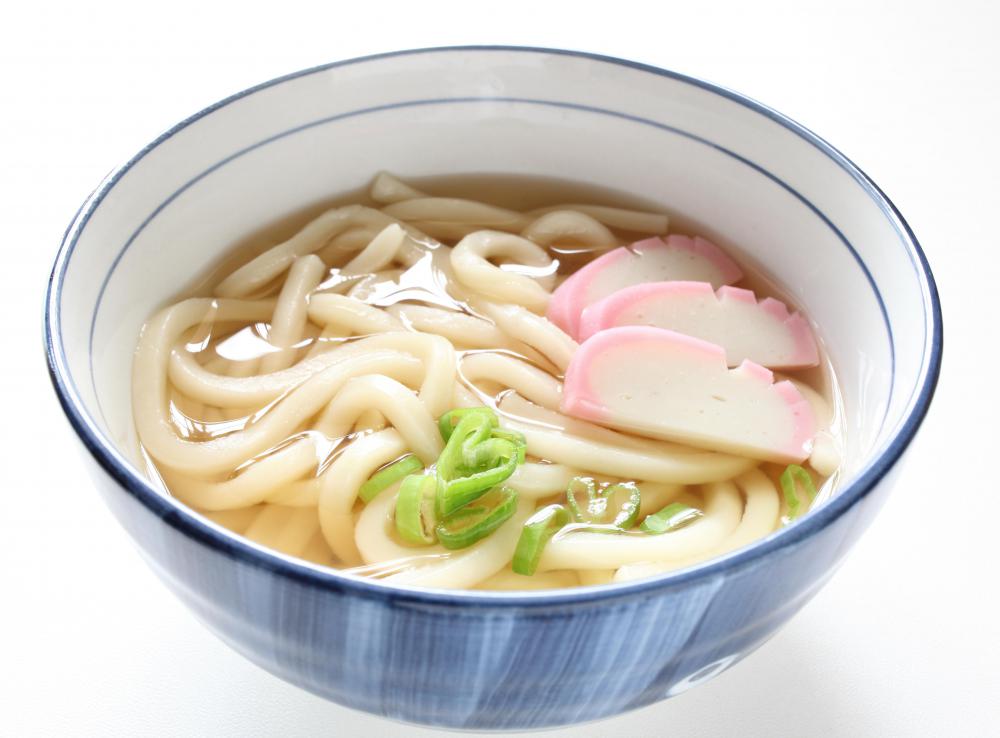At WiseGEEK, we're committed to delivering accurate, trustworthy information. Our expert-authored content is rigorously fact-checked and sourced from credible authorities. Discover how we uphold the highest standards in providing you with reliable knowledge.
What is Udon?
Udon is both the name used for a specific type of Japanese noodle, and for dishes made with that noodle. Across Japan, these dishes are quite varied, from a plain quick snack to a complex dish with a wide assortment of ingredients. Many Asian markets carry udon, along with supplemental ingredients which can be used to make the dishes. It is also common to see a selection of udon choices on the menu of a Japanese restaurant, and in Japan, it is ubiquitous at small roadside stands and shops. People can also make udon at home, experimenting with an assortment of ingredients for their own unique takes on the classic dish.
The noodle is a thick wheat-based noodle which can be squared or round. As is the case with other noodles, udon will puff up when it is cooked, making the noodles even bigger, and very dense with a generally soft texture. The dried noodles can sometimes be found in coils, often with packets of seasoning or dressing to accompany the noodles once they are cooked. Dried noodles are also available in long sticks, like Italian pasta.

Traditionally, udon is served in a broth which may be supplemented with ingredients like fried eggs, chopped vegetables, fish cakes, dumplings, ham, or tempura fried shrimp. Each dish has its own distinctive name, such as kitsune udon, which is made with deep fried pieces of tofu, or yakiudon, stir fried udon in a dark sauce. Some restaurants accompany their udon menu with an assortment of illustrative photographs, for people not versed in the many options.

The most basic and traditional dish is kake udon, noodles made in a simple broth known as kakejiru. Kakejiru blends soy sauce, mirin, and dashi, three common ingredients in Japanese cuisine. Mirin is a type of rice wine, while dashi is a broth made from seaweed and dried fish, boiled together and then strained. Kake udon may be topped with slivers of green onion, horseradish, or carrot in some regions.

Different parts of Japan have different udon traditions, but as a general rule the noodles are served hot in the winter and cold in the summer. Cold udon in a refreshing broth can be a rather cooling afternoon snack, especially when paired with cool vegetables like cabbage and cucumber. In the winter, the broth tends to be heartier, with a heavier focus on protein and rich ingredients which will make the dish warming and filling.
AS FEATURED ON:
AS FEATURED ON:














Discussion Comments
I like having Japanese udon with curry. I buy Japanese curry that comes in a small box in tablet form at the Asian store, add broth to it to make the sauce and mix in cooked udon, along with mushrooms and peas. It's so easy and really tasty.
I've never had cold udon though. How do I make the broth for cold udon? Can anyone give me some tips?
I personally like the fresh udon they sell at the store. It's really easy to cook with it because it stays in the freezer and you can take some out when you are ready to cook. I don't like making it at home because getting the right consistency is not that easy. Dry udon is my last option if I can't find the fresh kind, I just think that tastes better.
The good thing about udon, or any other Japanese noodles really, is that you can add whatever you want in it. It may not be the original way of making it, but it's easy to suit udon to your taste and your fridge. If I can't find the right vegetables for an udon recipe for example, I use whatever is in my fridge- carrots, zucchini, bok choy. If I am craving for some protein, I might add some cheese, tofu or eggs in it. I might add spices if I'm looking for something different with extra flavor.
In fact, if you like Japanese food and especially enjoy cooking, I think that udon is a great way to experiment and discover new flavors. You can also make it closer to what your taste buds are used to which will make it a fun and easy meal for you, instead of an exotic and difficult recipe.
My mom makes her own udon noodles. She just mixes flour, water and salt together and kneads it for some time. Then, she puts it in a plastic bag and puts it under a big rock that we have at home. I think anything heavy works for this. The heaviness and pressure makes the dough come together and become even.
I've heard people do this by walking on the plastic bag too. I guess whichever works better, you could do. When it's all nice, uniform and flat, mom takes it out and cuts it into strips. I love udon but I'm too lazy to do all this so I just buy the dry kind at the store when I'm not home. But fresh udon definitely tastes better if you don't mind making it.
Post your comments